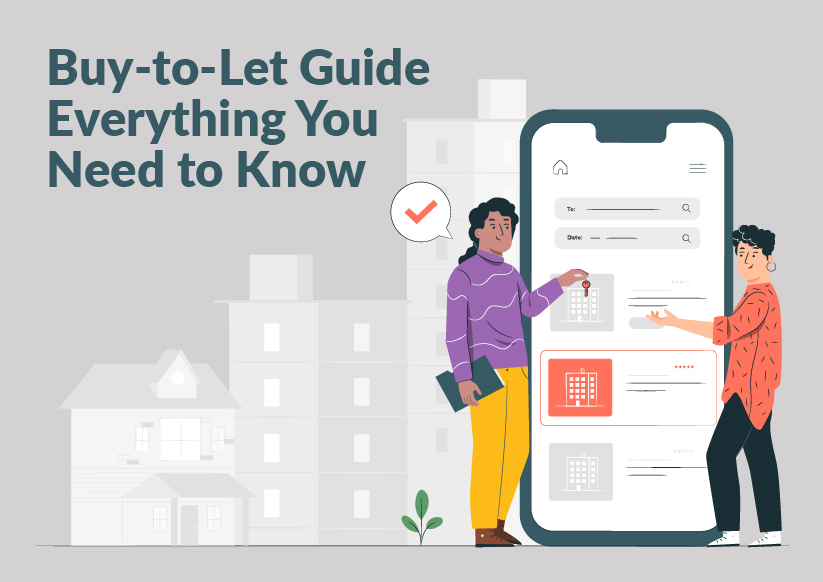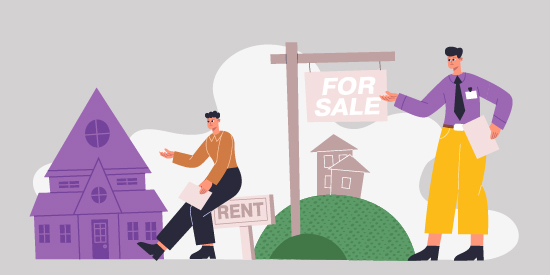Buy-to-Let Guide – Everything You Need to Know

In this buy-to-let guide, we give you the low-down on: the pros and cons of buying a rental property, useful buy-to-let advice for choosing the right property and what to consider when you’re choosing between a flat and a larger property such as a house.
Additionally, this guide can help you to understand the common requirements and responsibilities associated with being a landlord. We’ll give you all the information you need in order to make an informed decision about whether buy-to-let is right for you.
What is a Buy-to-Let Investment Property?
When buying a buy to let property, an investor purchases a house or apartment with the intention of renting it out to tenants rather than living in the property. The idea is to make a profit on the investment by generating income via monthly rent or capital gains when they come to sell the BTL property (and, in the best of circumstances, profit from both).
Buy-to-let investments can be a great way to build wealth over the long term and provide a steady income. Rental income can be used to pay off the mortgage and the property can appreciate in value over time. Furthermore, any capital gains made on the sale of a buy-to-let property are free from capital gains tax. For those who want to become property investors, but don’t have the funds to purchase the property outright, BTL mortgages are available from most lenders. These mortgages are specifically for buy-to-let investments, often with better rates than standard residential mortgages.

Overview of the UK Rental Market
Rental Market in 2021 & 2022
Our buy-to-let guide wouldn’t be complete without a look at the state of the UK rental market.
In 2021, the UK property market was thriving, with 4.4. million households privately renting. Alongside a steady stream of tenants looking for rental accommodation. At the same time, 2021 saw UK property prices jump to record levels. The average home in the UK now costs £248,857. This is 30% higher than the same time a year previously!
Meaning, many would-be home buyers are being priced out of the market or renting for longer while they save enough to put down a deposit and get a mortgage.
In the UK’s northern cities, in particular, ongoing regeneration and incoming investment is attracting young professionals and those migrating away from London enticed by new job opportunities and attractive (not to mention cheaper) lifestyles. This growing population is creating a housing shortfall set to underpin rental growth in 2023 and beyond, and making the North one of the best areas for buy to let in the UK.
Check out this article to see more of the best places for buy to let!
Rental Market in 2023 & Beyond
The North East is currently one of the country’s most affordable rental markets, which is good news for landlords as affordability and strong growth indicate there is room for rents to increase. Over the last 10 years, rents in the North East region have increased by 1% per year, compared to the average growth of UK rent which was 21%.
According to the December 2022 statistics, the average house prices in England have decreased by 0.2% compared to November 2022. However, the annual price increase of 10.3% has resulted in the average property value reaching £315,119. The regional data also reveals that the East Midlands has observed the highest annual price rise of 12.3%, while Yorkshire and Humber have experienced the greatest monthly growth of 0.6%. On the other hand, London has seen the lowest annual price growth, with an increase of only 6.7%. The South West has witnessed the largest monthly price decline, with a movement of -1.8%.
Why Buy-to-Let? Pros and Cons
Before we get to the upsides, this section of our buy-to-let guide will consider some of the trickier details that landlords need to know.
While the UK rental market offers a lot of potential, it’s important to acknowledge that in recent years landlords have been hit by rising interest rates and tax changes that have put a squeeze on the profits compared to previous decades. Below we outline some of the fees and costs any landlord in the UK will need to consider.
What are the disadvantages of buy-to-let:
-
Tax on Rental Income
Any prospective landlord should keep in mind that they will be subject to tax on any rental income they generate, which is taxed at their relevant tax band. In addition, compared to previous years, landlords with furnished properties can no longer claim 10% ‘wear and tear’ costs against any tax bill, but they can claim for actual costs of damage and repairs. Relief on mortgage interest has also been capped since early 2020 at a basic rate of 10%, whether you are a higher or additional rate taxpayer, which can significantly eat into profits.
-
Capital Gains Tax
Buy-to-let properties are still subject to capital gains tax when you come to sell which is based on any increase in the property’s value. Capital gains tax is set at 18% or 28% depending on a landlord’s tax bracket. It is important to consider this when calculating the potential profit of a buy-to-let property.
In addition, landlords should also be aware of the annual exempt amount when it comes to capital gains tax. This is the amount that you can earn without having to pay tax and is currently £12,000 for individuals and £6,000 for trusts. Any amounts earned over this are subject to capital gains tax, so careful planning is essential in order to keep within these limits.
-
Stamp Duty on Additional Properties
Since 2016, any additional property with a value over £40,000 is subject to an additional 3% Stamp Duty, which includes buy-to-let homes. Find some tips on how to avoid stamp duty on a second home here.
The 3% Stamp Duty can be a significant additional cost when purchasing an additional property. It is important to be aware of how Stamp Duty works. It is important to seek professional advice to ensure that you are aware of any potential exemptions and to ensure that your purchase is as tax efficient as possible.
-
Getting a Buy-to-Let Mortgage
Landlords should note that if they cannot purchase their property outright, they’ll need to apply for a mortgage. Differences exist between a buy-to-let property and a residential mortgage (which applies to property you plan to live in).
Rather than the mortgage being based on the rate of your salary, a lender will view the rental income as the primary income source. Usually a lender expects anticipated rental income to meet around 125% of monthly income payment on the mortgage, known as “rental cover”. Some lenders have increased rental cover to 145%, but this depends on the bank.
As well as mortgage payments, a deposit for a buy-to-let home tends to be bigger than on a residential property. Sometimes a deposit can be up to 40% of the property price.

When is buy-to-let worth it? The Upsides
After reminding landlords of some of the downsides of having a rental property, a buy-to-let guide needs to consider the upsides too.
Looking at a long-term basis, a buy-to-rent property tends to be a strong investment. While the housing market fluctuates, on the whole, there is a positive upward trend. For example:
- compared to 10 years ago, average property prices are today 34% higher
- and 212% higher than two decades ago.
There are also some areas of the UK that are tipped for huge growth. Particularly cities in the North East of England. With plenty of opportunities to make a profit with property, as long as you get to know which cities are tipped for the biggest increases in house price growth there is profit to be made.
As well as the general upward trend of property price growth, overall rents tend to increase over the long-term, too. There will always be a market of people looking to rent private property. Either in the medium or long-term and with high house prices, many younger generations are renting longer before they buy.
This means that landlords can benefit from the increasing demand for a rental property in the UK.
Top Buy-to-Let Advice
-
Location is Key
When it comes to buy-to-let property investment, location is everything, and rather than personal preference of where you want to live, like with your own home, it’s important to invest in buy-to-let houses in the right area based on what kind of tenant you are targeting.
While finding a property at a bargain price is great, it’s important to consider whether there’s a rental market in that location (you can take a look at the cheapest place to buy a property in the UK here, and our recommendations for locations that are relatively cheap, but come with buy-to-let prospects too).
-
Know Your Tenant Target Market
As well as location, the type of property is important too. If you are targeting the student market for example, it’s important to find a property of the right size with the right amenities and in a location that’s appealing.
Students tend to seek out affordable properties close to campuses and nightlife. In contrast, families tend to seek out properties in the suburbs with good transport links and in an area with good schools.
-
Rental Yield Vs Capital Growth
When it comes to your buy-to-let investment, usually you will rely on capital growth – increase in the property’s value over time, or rental yield – the income generated from the property.
When it comes to the property you are purchasing, you need to find a balance between the two or calculate which has the greater advantage.
For example, if the initial costs of the property are high, you’re unlikely to attain a good rental yield and will be more dependent on the property prices rising. In contrast, if you purchase a cheaper property to rent out you’ll be relying on the rental yield.
Good rental yields should sit around 5%, but with some properties such as student properties or HMOs you can generate yields of much higher. You can discover more in our guide on what makes a good rental yield.
-
Consider Type of Property
The type of property you invest in can make a big impact. Consider that a House of Multiple Occupation – a property with three tenants or more that share a bathroom and kitchen facilities may bring in more rent and is often popular with student markets.
However, many lenders have restrictions on mortgages for these types of properties. Read on to find out some of the pros and cons when it comes to purchasing a buy-to-let flat or house.
-
Buying a Flat to Rent
Buying a flat as a buy-to-let investment is generally a good strategy as they tend to have low vacancy rates and high demand, delivering dependable rental income to landlords and making them a less risky option.
Apartments located near the town centre with strong transport links tend to have greater appeal and experience high capital growth, particularly when renting to students, small families, couples and young professionals.
Apartments are generally cheaper to finance too. Because apartments are generally more affordable than a larger home, the initial deposit and mortgage repayments tend to be lower, which is a better option for landlords with a lower budget.
As mentioned before, rental yields are an important measure of income for investors and indicate the profitability of a property relative to expenditure. On the whole, apartments tend to offer higher rental yields and have less outgoing costs like repairs and maintenance because they are smaller and tend to be more modern.
Another benefit of apartments is that often you can find a property that is off-plan. With an off-plan property, an investor will buy a property that is not yet completed from a developer.
Off-plan properties can often be had for below-market rates, are popular with renters and tend to deliver strong capital growth. Investors can also cherry-pick the units with the most appealing features for renters, boosting the likelihood they can find tenants. Read more about the benefits of an off-plan property here.
-
Buying a Rental Property
Purchasing a larger property such as a house over an apartment is something many investors will consider. In light of the COVID pandemic, houses offer a number of amenities which are becoming increasingly appealing to renters.
Post-pandemic preference has shifted to properties with more square footage and outdoor areas, which has made larger properties, like houses, more appealing to renters.
It’s important to choose a property with the right features, such as a garden or garage for families, or enough bedrooms to make it appealing to students who are looking to share a property.

Buy-to-Let Properties for Sale that Should be on Your Radar
No buy-to-let guide is complete without offering some suggestions of properties that might be suitable. If you are considering a buy-to-let-property, here are some developments you might want to take a look at, each with high potential for strong rental yields and capital gains.
Sky Garden, Leeds
Sky Garden in Leeds is located in the much sought-after Southbank and includes the full refurbishment of the Grade II Listed Midland Mills and an iconic residential tower. With house prices on the rise. as much as 28% by 2024, Leeds will probably be the number 1 city in the UK for capital growth. Which consequently makes a buy-to-let property in this location an attractive prospect.
Bridgewater Wharf, Manchester
Close to the city centre, Bridgewater Wharf is located on a stunning waterfront. Manchester consistently tops the charts for property growth in the UK. Additionally, the property boastes a modern and stylish living spaces and sought-after amenities like an onsite gym. Located in a highly desirable area and with low property prices of from £128,495, the potential for strong rental yields is high.
______________________________________________________________________________________
As our buy-to-let guide has shown, The UK rental market offers potential landlords plenty of opportunity and with high rental and property price growth predicted in the UK’s Northern cities in particular there’s plenty of profit to be made in terms of capital gains and rental yields. Whether you buy a flat to rent or a larger property like a house, be sure to understand your tenant market and find a property in a desirable location. To find out more about the benefits of investing in the UK’s buy-to-let market, get in touch with one of our experts.

